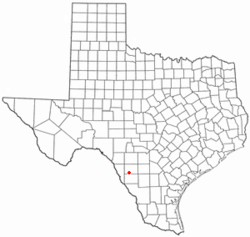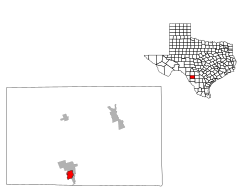Crystal City, Texas
| Crystal City, Texas | |
|---|---|
| City and county seat | |

Sacred Heart Catholic Church in Crystal City
|
|
| Nickname(s): Spinach Capital of the World | |
 Location of Crystal City, Texas |
|
 |
|
| Coordinates: 28°41′4″N 99°49′40″W / 28.68444°N 99.82778°WCoordinates: 28°41′4″N 99°49′40″W / 28.68444°N 99.82778°W | |
| Country | United States |
| State | Texas |
| County | Zavala |
| Government | |
| • Mayor | Frank Moreno Junior |
| Area | |
| • Total | 3.6 sq mi (9.4 km2) |
| • Land | 3.6 sq mi (9.4 km2) |
| • Water | 0.0 sq mi (0.0 km2) |
| Elevation | 558 ft (170 m) |
| Population (2010) | |
| • Total | 7,138 |
| • Estimate (2014) | 7,513 |
| • Density | 2,000/sq mi (760/km2) |
| Time zone | Central (CST) (UTC-6) |
| • Summer (DST) | CDT (UTC-5) |
| ZIP code | 78839 |
| Area code(s) | 830 |
| FIPS code | 48-18020 |
| GNIS feature ID | 1355449 |
| Website | cityofcc |
Crystal City is a city in and the county seat of Zavala County, Texas, United States. The population was 7,138 at the 2010 census. It was settled as a farming and ranching community and was a major railroad stop being 110 miles (180 km) from San Antonio. Spinach became a major crop and the city has promoted itself as "Spinach Capital of the World." During World War II, a large internment camp was located here. The town is also noteworthy in the history of Mexican American political self-determination for the founding of the La Raza Unida Party.
Crystal City was originally settled by American farmers and ranchers producing cattle and various crops. Crystal City was a major stop along with San Antonio, Uvalde, Carrizo Springs, and Corpus Christi on the defunct San Antonio, Uvalde and Gulf Railroad, which operated from 1909 until it was merged into the Missouri Pacific Railroad in 1956. From 1909 to 1912, the SAU&G was known as the Crystal City and Uvalde Railroad. There was also an eastern link to Fowlerton near Cotulla in La Salle County. The remaining San Antonio-to-Corpus Christi route is now under the Union Pacific system.
The successful production of spinach evolved into a dominant industry. By March 26, 1937, the growers had erected a statue of the cartoon character Popeye in the town because his reliance on spinach for strength led to greater popularity for the vegetable, which had become a staple cash crop of the local economy. Early in its history, the area known as the "Winter Garden District" was deemed the "Spinach Capital of the World" (a title contested by Alma, Arkansas). The first Spinach Festival was held in 1936. It was put on hold during World War II and later years. The Festival was resumed in 1982. The Spinach Festival is traditionally held on the second weekend in November, and draws former residents (many of them former migrant farm workers) from Michigan, Wisconsin, Minnesota, California, Washington State, and beyond.
...
Wikipedia
